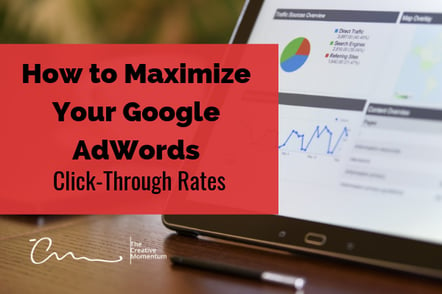
Many marketers consider pay-per-click (PPC) ads to be an important component of any successful marketing campaign. Strong PPC ads drive traffic to your website, increase conversions, and build brand authority using targeted keywords and complementary content. Businesses need internet users to interact with these ads in order to justify money invested in their PPC campaigns, and user interaction is most often measured through an ad’s click-through-rates (CTR).
Here’s how you can optimize your AdWords PPC campaigns to maximize CTR and create successful ads that convert.
Five Tips to Increase AdWords Click-Through-Rates
High CTRs influence what you pay for sales and leads. Naturally, the goal is to increase your click-through-rates in order to reduce out-of-pocket ad spend and stretch your AdWords budget. This gives you more money to invest in ads, and more higher-performing ads keep the clicks coming through to your website. It’s your job to keep the PPC ad wheels well-oiled and turning smoothly. Here are five tips that can help you do that.
1. Optimize Keywords and Ad Copy
Keyword research tells marketers how well keywords perform and the price per click. Analyze this data by researching your competitors. Which keywords are they spending their advertising dollars on? Can your ad budget compete? Some companies find success by bidding on branded competitor keywords like company names.
Once you identify the keywords you want to target, write your strategic ad copy. Headlines need to be persuasive. Copy snippets should entice users to click through for more information about your product or service. And most importantly, that information must match user intent.
2. Take Advantage of Expanded Text Ads
Brevity may not be enough when it comes to PPC ads and CTRs. Your ads have to include enough information to entice, inform, and persuade, and sometimes you can’t do that with just a headline and a few follow-up words. Testing ad extensions and expanded text ads makes all the difference.
Expanded text ads give marketers two additional 90-character text fields—a third headline and a second description—to work with. They’re also mobile optimized and allow for two optional URL path fields, which lets you get more specific and link to dedicated landing pages buried deeper in your website.
3. Link Ads to Dedicated Landing Pages
Be specific with your PPC ad intentions, and link your ads directly to dedicated landing pages that help direct traffic and maximize conversions. Too often, ads redirect users to generic homepages or content that doesn’t apply to a user’s original search query. Savvy users can even see where they’re being led (through an ad’s URL) before they click through to your site.
Take the opportunity to really drill into unambiguous search queries, keywords, and targeted content through PPC landing page best practices. This is also a chance to optimize for targeted keywords by including them in the landing page URL.
Your PPC ads need to be as clean and clear as possible, and keyword-focused URLs redirecting to dedicated landing pages are a great way to clear up any confusion both for users and search engine crawlers.
4. Improve Calls to Action
It’s tempting to slap a “Buy Now” button on your PPC ad and call it a day, but that kind of ad apathy isn’t helping your brand. Your call-to-action (CTA) compels users to take the next step and click through to your awesome dedicated landing pages. Know your audience, and don’t be too pushy or generic when crafting your CTA. Goal-oriented, well-written, personalized calls-to-action convert 202% better than their basic counterparts, which means you’re missing out on a lot of CTR traffic if your CTAs aren’t doing their jobs. Smart marketers use tactics like geotargeting and browser usage habits to tailor PPC ad CTAs to different user subsets to maximize click-through rates.
5. Pause Non-Performing Ads
Not all ads are created equal, regardless of how well you’d like them all to perform. It’s inevitable that not all of your ads are going to be winners. You can optimize, spend, and optimize some more with the hope that someday a particular ad will find its audience, but you’re wasting money after a certain point. Weigh ad spend against CTR performance, and know when it’s time to pull the plug on non-performing ads. You’re better off starting fresh with a new ad than you are trying to limp along with one that’s not performing.
Fortunately, changes to PPC ads aren’t permanent, and you can experiment with what works best for your brand until you find the perfect balance for ad success. Remember to A/B test important changes and utilize user data to roll out different ads to different audiences.
Invested Time and Good Timing Lead to CTR Success
It takes time for most worthwhile stretch-goal marketing tactics to perform well, and ad click-through-rates are no exception. Your CTRs won’t improve overnight after you implement changes, and that’s okay. Also, as Robert Brady for Small Business Insider points out, you can put the right offer in front of the right audience and still have a PPC ad campaign fail if the timing isn’t right. AdWords offers a variety of data-driven tables and tools to help you understand when and why an ad is or isn’t converting. Use the tactics listed above to optimize your PPC ads in a way that influences and increases click-through rates.


